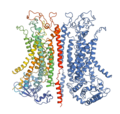Calcium-dependent chloride channel
(Redirected from Calcium-activated chloride channel)
Calcium-dependent chloride channels (CaCCs) are a class of ion channels in cell membranes that allow the movement of chloride ions across the membrane. These channels are activated by an increase in intracellular calcium levels, which can occur through various mechanisms, including the activation of G protein-coupled receptors (GPCRs) or the release of calcium from intracellular stores. CaCCs play critical roles in various physiological processes, including the regulation of electrical excitability in neurons, muscle contraction, and the secretion of fluids in exocrine glands.
Function
The primary function of calcium-dependent chloride channels is to regulate the flow of chloride ions across cell membranes, which is crucial for maintaining the electrochemical gradient and cell volume. In neurons, the activation of CaCCs can lead to hyperpolarization of the cell membrane, which decreases the likelihood of action potential generation and can modulate neuronal excitability. In smooth muscle cells, CaCCs contribute to muscle contraction by depolarizing the membrane and promoting calcium influx. In exocrine glands, such as the salivary gland, pancreas, and sweat glands, CaCCs facilitate the secretion of chloride-rich fluids, which is essential for various bodily functions.
Types
There are several types of calcium-dependent chloride channels, which can be classified based on their molecular structure and activation mechanisms. The most well-characterized CaCCs include those encoded by the TMEM16A (also known as ANO1) and TMEM16B (ANO2) genes. These channels are part of the TMEM16 (or anoctamin) family, which consists of ten members (TMEM16A to TMEM16K) with diverse functions. Other potential CaCCs include members of the Bestrophin family, although their role as bona fide calcium-activated chloride channels is still under investigation.
Clinical Significance
Calcium-dependent chloride channels are implicated in various diseases and disorders. For example, mutations in the TMEM16A gene have been associated with certain types of cancer, including breast and gastrointestinal cancers. In the respiratory system, the dysfunction of CaCCs can contribute to the pathophysiology of cystic fibrosis and chronic obstructive pulmonary disease (COPD), as these channels are involved in mucus secretion and airway hydration. Targeting CaCCs with specific inhibitors or activators has been proposed as a therapeutic strategy for these and other conditions.
Research
Research on calcium-dependent chloride channels is ongoing, with studies aimed at understanding their molecular structure, regulation, and physiological roles. Advances in this field may lead to the development of new therapeutic approaches for diseases associated with CaCC dysfunction.
| Ion channels | ||||||||||
|---|---|---|---|---|---|---|---|---|---|---|
This ion channel related article is a stub.
|
This article is a membrane protein–related stub. You can help WikiMD by expanding it!
Transform your life with W8MD's budget GLP-1 injections from $125.
W8MD offers a medical weight loss program to lose weight in Philadelphia. Our physician-supervised medical weight loss provides:
- Most insurances accepted or discounted self-pay rates. We will obtain insurance prior authorizations if needed.
- Generic GLP1 weight loss injections from $125 for the starting dose.
- Also offer prescription weight loss medications including Phentermine, Qsymia, Diethylpropion, Contrave etc.
NYC weight loss doctor appointments
Start your NYC weight loss journey today at our NYC medical weight loss and Philadelphia medical weight loss clinics.
- Call 718-946-5500 to lose weight in NYC or for medical weight loss in Philadelphia 215-676-2334.
- Tags:NYC medical weight loss, Philadelphia lose weight Zepbound NYC, Budget GLP1 weight loss injections, Wegovy Philadelphia, Wegovy NYC, Philadelphia medical weight loss, Brookly weight loss and Wegovy NYC
|
WikiMD's Wellness Encyclopedia |
| Let Food Be Thy Medicine Medicine Thy Food - Hippocrates |
Medical Disclaimer: WikiMD is not a substitute for professional medical advice. The information on WikiMD is provided as an information resource only, may be incorrect, outdated or misleading, and is not to be used or relied on for any diagnostic or treatment purposes. Please consult your health care provider before making any healthcare decisions or for guidance about a specific medical condition. WikiMD expressly disclaims responsibility, and shall have no liability, for any damages, loss, injury, or liability whatsoever suffered as a result of your reliance on the information contained in this site. By visiting this site you agree to the foregoing terms and conditions, which may from time to time be changed or supplemented by WikiMD. If you do not agree to the foregoing terms and conditions, you should not enter or use this site. See full disclaimer.
Credits:Most images are courtesy of Wikimedia commons, and templates, categories Wikipedia, licensed under CC BY SA or similar.
Translate this page: - East Asian
中文,
日本,
한국어,
South Asian
हिन्दी,
தமிழ்,
తెలుగు,
Urdu,
ಕನ್ನಡ,
Southeast Asian
Indonesian,
Vietnamese,
Thai,
မြန်မာဘာသာ,
বাংলা
European
español,
Deutsch,
français,
Greek,
português do Brasil,
polski,
română,
русский,
Nederlands,
norsk,
svenska,
suomi,
Italian
Middle Eastern & African
عربى,
Turkish,
Persian,
Hebrew,
Afrikaans,
isiZulu,
Kiswahili,
Other
Bulgarian,
Hungarian,
Czech,
Swedish,
മലയാളം,
मराठी,
ਪੰਜਾਬੀ,
ગુજરાતી,
Portuguese,
Ukrainian
Contributors: Prab R. Tumpati, MD

